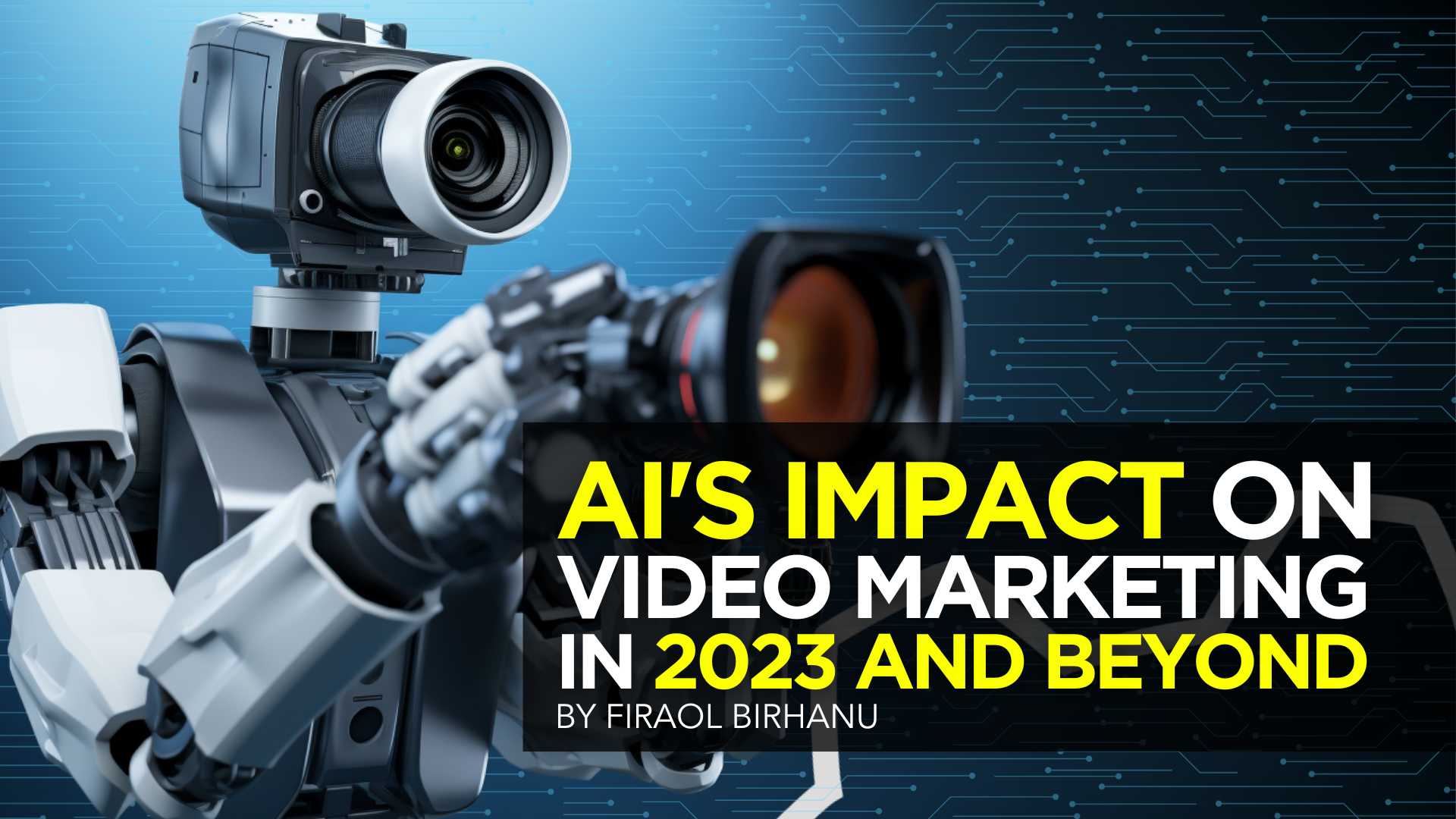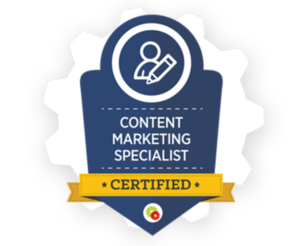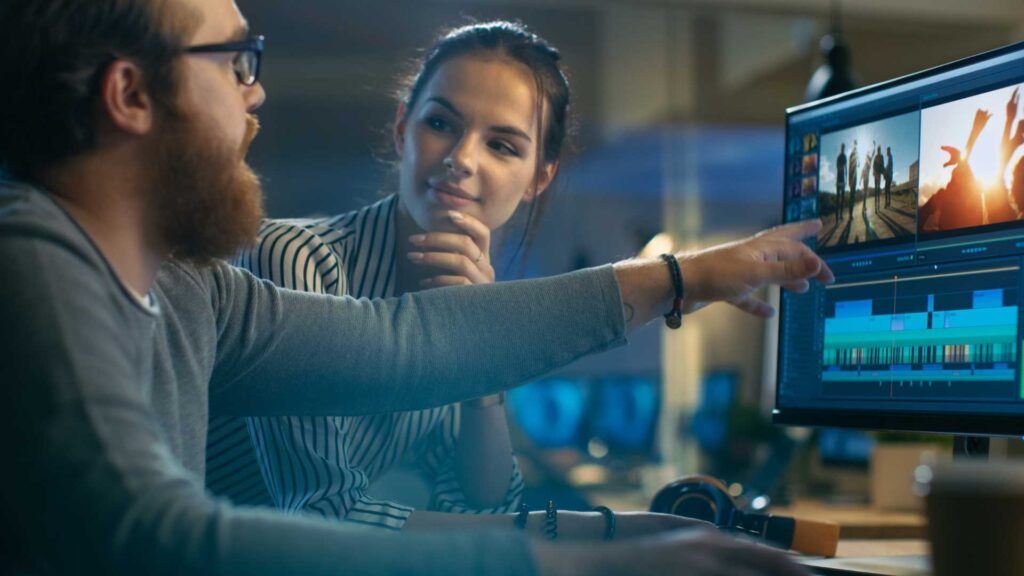MARKETING
AI’s Impact on Video Marketing in 2023 & Beyond

In a world dominated by video marketing, artificial intelligence (AI) plays a role, in transforming the industry. By improving customer experiences increasing engagement and providing content AI is reshaping video marketing strategies both now and, in the future.
Let’s start with some overall stats,
In fact, 96% of marketers have already witnessed the positive return on investment (ROI) that AI-powered video marketing brings. In general, nowadays, 75.7% of marketers are using AI tools for work.
So, let’s dive into how AI is transforming the landscape of video marketing strategies and explore its exciting future.
What is Video Marketing?
Video marketing is a tactic that companies employ to connect with their desired audiences showcase their offerings and transform viewers into customers. This approach encompasses the creation and dissemination of captivating videos, on platforms to convey messages and establish brand awareness.
The Impact of Video Marketing is Undeniable
Heightened Brand Awareness: Research reveals that video marketing contributes significantly to enhancing brand awareness, with 64% of marketers acknowledging its effectiveness.
Videos are dominating the content marketing industry!
Videos possess a unique power to captivate attention, narrate a brand’s story, and leave an enduring imprint on viewers. By leveraging visual and auditory elements, videos enable brands to stand out amidst fierce market competition.

Amplified Conversions: Valuable consumer insights from 2022 demonstrate the ability of video marketing to bolster conversion rates. Videos have the power to inspire and prompt viewers into action be it making a purchase subscribing to a newsletter or establishing a connection, with a company.
However, that depends on the production quality,
By showcasing products or services in action and addressing customer pain points, videos become a persuasive catalyst for driving conversions.
Elevated Engagement: videos, be short form or long, have the most power to keep audacious captivated for a long time. People spend an amount of time on social media watching videos, which demonstrates the appeal and effectiveness of this medium. Videos provide an experience by combining visuals, audio, and storytelling making it more engaging and interactive.
People spend an amount of time on social media watching videos, which demonstrates the appeal and effectiveness of this medium. Videos provide an experience by combining visuals, audio, and storytelling making it more engaging and interactive.
Unforgettable Brand Recall: Videos leave a lasting imprint in viewers’ minds, significantly enhancing brand recall. Compared to text or images alone, videos exhibit a higher recall rate.
Videos create a lasting impression, on viewers by using captivating visuals, storytelling techniques, and emotional connections. This ensures that the brand stays at the forefront of their minds when making purchasing decisions.
Heightened Social Media Activity: The pandemic has amplified the significance of video marketing, leading to a surge in social media activity. As social media platforms prioritize video content, consumer behavior has shifted accordingly.

Nowadays, it seems social media is treated as a marketplace,
Businesses have adeptly capitalized on this trend by crafting compelling videos that resonate deeply with their target audience, fostering stronger connections and interactions across social media platforms.
So we can say video marketing serves as a dynamic and immersive medium that enables businesses to artfully narrate their stories, showcase their offerings, and forge authentic connections with their target market! Its ability to evoke emotions, deliver captivating narratives, and provide valuable information sets video marketing apart as a pivotal strategy in today’s digital landscape.
How is AI Changing Video Marketing Strategies?
As we step into 2023, AI is paving the way for transformative changes in video marketing strategies. Here are eight key ways AI is reshaping the landscape of video marketing:
AI-Powered Video Editing for Efficiency & Quality
AI-powered video editing tools automate tasks such as shot selection, transitions, color grading, and sound mixing, saving time and improving video quality. AI enables marketers to concentrate on developing engaging content and providing seamless user experiences by streamlining the editing process.
With AI’s ability to analyze vast amounts of data and learn from patterns, it can even suggest the most effective editing techniques and styles based on audience preferences and industry trends, ensuring that every video is optimized for maximum impact.

Want to get certified in Content Marketing?
Leverage the tools and channels to predictably and profitably drive awareness, leads, sales, and referrals—EVERYTHING you need to know to become a true master of digital marketing. Click Here
Some of the Best AI-Powered Video Creators and Editors
Let’s mention some of the interesting AI-powered platforms that help to create and edit marketing videos for marketing purposes.
- DeepBrain AI: It’s an innovative AI platform that provides a one-of-a-kind solution for making AI Avatar videos in a matter of minutes. DeepBrain AI generates natural-sounding speech with various accents and tones, resulting in a realistic and engaging user experience.
- Pictory: Pictory is one of the best AI-powered video creation tools, with plenty of interesting features. The platform is popular among marketers, including YouTubers, bloggers, course creators, and agency owners.
- Elai: Elai is an ideal video marketing solution for digital marketers who want to generate interesting videos. The AI-powered system can produce accompanying text from the inputted audio, making it easy to add subtitles, voiceovers, and other features.
AI Voiceovers and Animation: Enhancing Visual Appeal
AI advancements in voiceovers and animation bring a new dimension to video content, enhancing visual appeal and increasing audience engagement. AI-generated voiceovers can provide seamless narration that matches the tone and style of the video, creating a more immersive and professional viewing experience.
Additionally, AI-powered animation tools enable marketers to bring complex ideas to life with visually stunning graphics and effects. By leveraging AI in voiceovers and animation, brands can elevate their storytelling capabilities, grab viewers’ attention, and effectively convey their messages.


Some of the Best AI-Powered Voice-Over Generators
So, nowadays a lot of marketers create marketing videos without recording themself. AI makes it too easy to create voice-overs, so marketers just need to write their script and these AI platforms generate interesting voice-overs for their videos.
- Lovo: It’s a professional content production tool that generates high-quality voice-overs and synthetic speech using Generative AI and text to speech technology. The platform is intended for marketers, HR professionals, sales teams, and content service providers of all sizes.
- Synthesys: It’s an AI-powered platform and a leader in the creation of algorithms for commercial applications that transform texts into voices and videos. Imagine adding a real human voice to your social media videos or online courses.
- Murf AI: It’s another great tool, AI voice-over and text to speech are two of the essential features of the Murf.AI platform. Murf gives you the option to create high-quality synthetic voices for a variety of applications, regardless of whether you require male or female voices and support for many languages.
Personalized Content: Deepening Engagement with Audiences
AI algorithms analyze customer data to deliver highly targeted and personalized content. This personalized approach enhances engagement, boosts conversion rates, and fosters more vital customer satisfaction and loyalty.
By leveraging AI-driven insights, marketers can understand customer preferences at a granular level and create video content tailored to their specific needs, pain points, and aspirations.
From personalized product recommendations to individualized storytelling, AI enables brands to forge deeper connections with their audiences and provide them with valuable content that resonates personally.
Advanced Analytics: Insights for Data-Driven Decisions
AI-powered analytics tools provide valuable insights into video performance, tracking metrics like views, engagement rates, and conversion rates. These data-driven insights can aid marketers in making wise choices and enhancing their tactics.


AI algorithms can go beyond surface-level metrics and dive into more nuanced aspects of video performance, such as audience sentiment analysis, emotional response tracking, and attention heatmaps.
With these insights, marketers can fine-tune their video content, iterate on successful elements, and experiment with new approaches, all to continuously improve performance and drive desired outcomes.
Hyper-Personalization with AI Recommendations
AI algorithms deliver hyper-personalized video recommendations based on individual preferences, interests, and browsing history. This focused strategy promotes brand loyalty, consumer happiness, and engagement.
By analyzing vast amounts of data, AI can identify patterns, behaviors, and affinities, enabling marketers to deliver video content that aligns with each viewer’s specific interests.
Whether it’s recommending related videos, personalized playlists, or tailored product suggestions, AI-powered recommendations create a highly personalized viewing experience, keeping audiences engaged and coming back for more.
AI-Driven Targeting & Optimization
AI enables precise targeting and optimization of video marketing campaigns by analyzing data on past search history, previous purchases, and social media interactions. This precise strategy maximizes conversion rates by ensuring that video content is delivered to the appropriate audience at the optimal moment.



Want to get certified in Content Marketing?
Leverage the tools and channels to predictably and profitably drive awareness, leads, sales, and referrals—EVERYTHING you need to know to become a true master of digital marketing. Click Here
AI algorithms can segment audiences based on demographic factors, interests, and behaviors, allowing marketers to create tailored video campaigns that resonate with specific customer segments.
Through continuous analysis and optimization, AI-driven targeting empowers marketers to allocate resources effectively, refine messaging, and achieve better campaign performance and ROI.
AI-Generated Content Creation
AI facilitates content marketing especially content creation in video marketing through generated scripts, automated production, and AI-assisted editing. Marketers have the opportunity to utilize AI to delve into concepts improve their work processes and boost productivity.
Scripts generated by AI can serve as a foundation, for video ideas enabling marketers to streamline the process of creating content. Automated production tools powered by AI can effectively manage tasks such, as creating scenes tracking objects, and rendering which ultimately results in a reduction of time and effort involved in video production.
AI-powered editing tools provide suggestions, for transitions, visual enhancements, and pacing to ensure that the end result of a video aligns, with the intended goals and connects effectively with the target viewers. In addition, nowadays, a lot of AI-powered platforms are available that can generate successful (high conversion) banner and video ad creatives.
AI-Powered Interactive Video Experiences
Interactive video experiences empowered by AI captivate audiences with personalized branching narratives and interactive decision-making. These captivating elements help to hold the attention of viewers resulting in increased levels of engagement and loyalty, towards the brand.


By using AI algorithms it becomes possible to analyze how viewers respond and behave while interacting with videos. This analysis allows for adjustments to the content ensuring a personalized experience, for each viewer.
Interactive videos powered by AI enhance viewer engagement and empowerment by providing options, quizzes, and personalized storylines. This fosters a bond with the brand. Boosts the chances of viewers taking desired actions.
The Future of Video Marketing with AI
As we gaze into the future the potential, for video marketing with AI appears bright. The latest trends suggest that AI technology will continue to progress presenting marketers with possibilities, for creative breakthroughs. Here are key ways video marketing with AI will continue to evolve in the near future:
- Enhanced deep learning algorithms for improved content personalization
- AI-powered real-time video analytics for instant insights and adjustments
- AI-generated dynamic video ads tailored to individual viewers in real-time
- Voice-controlled video experiences powered by AI voice assistants
- AI-driven emotional analysis for personalized video recommendations based on mood
- Automated video translations for seamless global audience reach
- AI-powered influencer marketing matching algorithms for effective collaborations
AI Changing the Video Marketing Quick Wrap-Up
Undoubtedly, AI is changing the video marketing strategy and will only be more popular in the future. As we enter 2023, AI is set to revolutionize video marketing and overall social media strategies in various ways. From AI-powered video editing and personalized content delivery to advanced analytics and interactive video experiences, AI brings innovation and efficiency to the field.
With AI’s capabilities, video marketing will continue to evolve and create highly impactful and immersive experiences for audiences. It’s an exciting time for video marketing as AI takes it to new heights of success.


![How AEO Will Impact Your Business's Google Visibility in 2026 Why Your Small Business’s Google Visibility in 2026 Depends on AEO [Webinar]](https://articles.entireweb.com/wp-content/uploads/2026/01/How-AEO-Will-Impact-Your-Businesss-Google-Visibility-in-2026-400x240.png)
![How AEO Will Impact Your Business's Google Visibility in 2026 Why Your Small Business’s Google Visibility in 2026 Depends on AEO [Webinar]](https://articles.entireweb.com/wp-content/uploads/2026/01/How-AEO-Will-Impact-Your-Businesss-Google-Visibility-in-2026-80x80.png)














